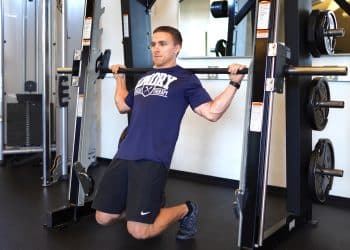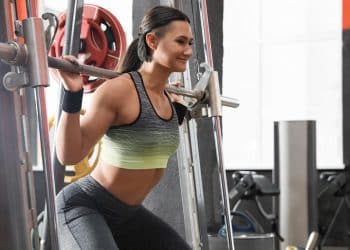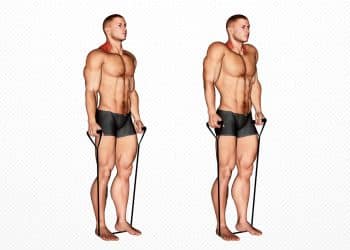A variation of a hotly debated exercise, Smith Machine Upright Row are a pull-focused movement that works the traps, upper back, deltoids, and biceps all in one. It’s a movement that should be used in moderation and with extra attention to form and only by those with healthy shoulders.
There’s a wrong and better way to do it which is why we put together this training guide to ensure you maintain healthy deltoids and achieve more muscle development.
In This Exercise:
- Target Muscle Group: Trapezius/upper back
- Type: Hypertrophy
- Mechanics: Isolation
- Equipment: Smith machine
- Difficulty: Intermediate/advanced
How To Do The Smith Upright Row
If there’s one exercise that you want to be extra careful with it’s the upright row. This isn’t the exercise to jump into without knowing the risks because let’s face it, injuries happen.
For that reason, we’ve included detailed step-by-step instructions along with a video example to help you get good results and avoid problems.
Disclaimer: Upright rows have the potential to cause shoulder impingement issues when used incorrectly, however, this risk is decreased when proper attention is given to lifting technique and the weight load. Never attempt to lift max loads when performing upright rows and if you do experience shoulder pain stop immediately.
We also recommend adding upright rows after you’ve warmed up with other exercises.
Level Up Your Fitness: Join our 💪 strong community in Fitness Volt Newsletter. Get daily inspiration, expert-backed workouts, nutrition tips, the latest in strength sports, and the support you need to reach your goals. Subscribe for free!
Step 1: The setup
Before you start rowing, make sure the bar is at an appropriate height, usually somewhere around the mid-thigh area so that you can get full arm extension during the negative portion of each repetition.
Face in the direction so that when you go to unhook the bar, you have to twist it back toward you.
Step 2: Body and hand position
Hand placement/grip width is going to be the most important step in setting up for Smith machine upright rows. Avoid using a narrow grip as it will fully internally rotate your shoulders and place more stress on your wrists which is what you do not want.
- Instead, use a wider than shoulder width grip on the bar which will naturally open up the shoulders and put them in more of an externally rotated position.
Step 3: Movement execution
Pro tip: Before adding weight to the bar do a few practice reps to make sure everything feels good in your shoulders. Then add a few pounds and repeat and when you’re ready, you can move up to your working weight.
There’s a lot of confusion about how high to pull the bar during upright rows. We recommend pulling the bar to about nipple height and no higher for the safety of your shoulders.
When you’re ready, stand close to the bar, assume a wider than shoulder width grip, stand straight, tense your core, and as you pull the bar up squeeze the trapezius muscles for one to two second. Lower the bar all the down and repeat for the desired number of repetitions.
If you have a few minutes we recommend checking out the following video instructional for a demonstration and detailed explanation of Smith upright rows.
Common Mistakes
Being an exercise with a bad rap, it’s best to avoid any of these common mistakes.
Using too much weight
Try ego lifting with this exercise and you’re asking for problems. This is not the movement to load max weights. Your deltoids are already internally rotated which increases the risk of shoulder impingement so if you’re going to do this exercise, use it as more of a higher rep movement.
Poor form/narrow grip
If you don’t understand the risks of this exercise or how to maintain proper form then it’s best to avoid this exercise altogether. That’s why it’s not recommend to use a narrow grip or to pull the bar too high. You do need to have a basic understanding of when something does not feel right and when you should stop at a certain point.
Not warming up properly
We personally would place upright rows further back in the que on pull day just to ensure the shoulders are sufficiently warmed up first. Even then, you still want to start light and do a few progressive sets working your way up to a challenging weight.
Benefits
Here are the pros of incorporating upright rows in your workouts.
Build bigger traps
While it’s not known as the safest exercise around, when performed with care, the upright row is still a beast when it comes to packing muscle mass on the deltoids. Many old-school bodybuilding legends swore by this exercise.
Work all three deltoid heads
Upright rows and its variations are one of the few movements that legitimately position you to activate all three deltoid heads (anterior, lateral and posterior) at the same time. Then consider the fact that it works the traps, upper back, biceps, and forearms too and you have one heck of a movement!
Strengthen the ball and socket shoulder joint
If you do this exercise safely and correctly, you will benefit from stronger and more resilient shoulders. It’s a benefit of training your shoulders in a position you normally wouldn’t.
Level Up Your Fitness: Join our 💪 strong community in Fitness Volt Newsletter. Get daily inspiration, expert-backed workouts, nutrition tips, the latest in strength sports, and the support you need to reach your goals. Subscribe for free!
Drawbacks
Here are some potential negatives of Smith upright rows.
Not the most loved exercise for its injury potential
Because of how the shoulders are positioned, upright rows are considered one of the worst exercises by many fitness experts and training resources. Done improperly and you could be looking at shoulder impingement issues. Does that mean it should be thrown away forever by everyone? Not necessarily. But be mindful of safety precautions such as the ones under the common mistakes category.
Not an ideal beginner exercise
While you are free to do whatever you want, we do not suggest upright rows for people who are not willing to go through a proper form checklist and start with just the bar or very light weights. To perform an exercise with your shoulders in an internally rotated position requires focus and attention to detail along with the ability to adjust and quit if something doesn’t feel right.
Variations and Alternatives
While Smith upright rows have their appeal, these variations and alternatives offer something different and some are arguably safer.
1. One arm Smith machine row
The advantage of doing a one arm Smith upright row is you can adjust your body to the bar whereas you cannot with the two arm variation.
To do it:
- Setup as you would for a two arm Smith upright row, gripping the bar with both hands a little wider than shoulder width. Remove one hand from the bar and this is your starting position. Pull the bar up to the nipple line, lower the weight and repeat.
2. Freeweight barbell upright row
The variation that started it all, freeweight barbell upright rows can sub out the Smith machine version. The advantage is that you’ll activate more raw strength as you have to stabilize the weight and move the bar according to your body position. With Smith pulls your body moves around the bar. Some people may also prefer this version as you’re not locked into a fixed implement. But both can be awesome exercises.
3. Dumbbell high pulls
The advantage that using dumbbells has over a barbell variation is the freedom of movement which allows you to externally rotate the shoulders in a safer position as you pull the weights up and back rather than just straight up. You can also more safely use heavier weights to really overload the muscles.
To do it:
- Grab a light or medium pair of dumbbells and hold them in front of your thighs with an overhand grip.
- Bend your knees, hinge slightly forward at the hips and engage your core muscles.
- Pull the dumbbells up high and rotate them back toward your shoulders so that your wrists are higher than your elbows. Retract the shoulders blades and pull your arms back to activate the upper posterior muscles.
4. Face pulls
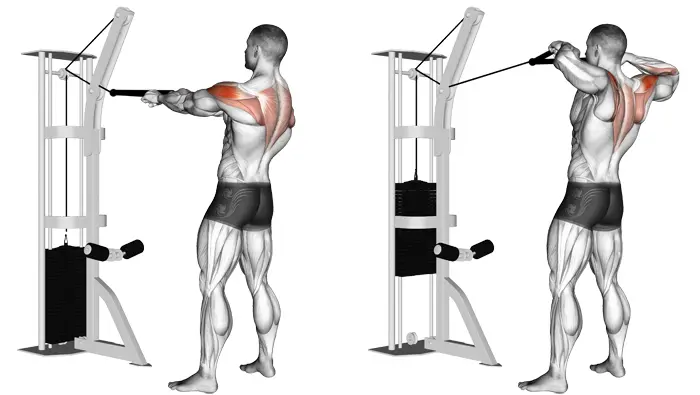
An exercise that everyone should be doing to combat anterior/posterior muscular imbalance and strengthen their lifting and daily posture, face pulls are also a user friendly exercise. They can be done using a cable machine, resistance bands, dumbbells, and even a barbell.
Also check out these 10 Best Face Pull Alternatives: Exercises for Better Posture and Shoulder Health.
5. Shrugs
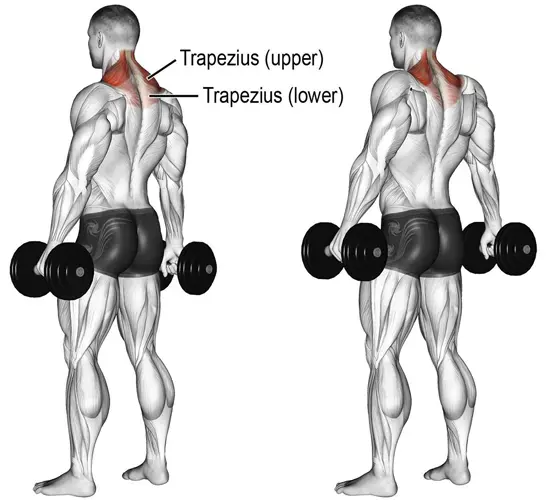
Hailed as the king of mass-building trapezius-focused exercises, shrugs are the best option for when you want to load the traps with heavy weight. And while the barbell shrug is a powerful variation, many find that they feel their traps working better using dumbbells and even cables. You also don’t have the concern about internal shoulder rotation.
That doesn’t mean you should throw all caution out the window though. Train within your strength capabilities and avoid using too much weight to the point you cannot maintain safe and proper form.
Program Smith Upright Rows In Your Training
While some exercises can be used a variety of different ways, we do not think Smith upright rows fit in that category. In fact, we’d recommend being very limited in incorporating this exercise because we care about long term shoulder health.
With that being said, we’d use lighter to moderate resistance at most, and stop a few reps before you reach muscle failure to avoid letting poor technique take over which could end up costing you.
We’d also suggest not doing Smith upright rows first in your workouts but after you’ve used other exercises to warm up and get blood flowing in the joints and muscles.
Sets and Reps
While you’re free to train as you please, we strongly caution against using low-rep, heavy weight sets upright rows. We’re talking anything in the 4-7 rep range that will cause you to reach muscle failure with the last few reps.
- We recommend 2-3 sets x 10-15 reps using light-moderate weight.
Muscles Worked
Upright rows are an upper body pulling muscle dominant exercise but it works several muscle groups to help support, stabilize, and perform the lift. Below we’ve included brief descriptions of the muscles involved in upright rows.

- Teres Minor – A part of the rotator cuff family, teres minor causes lateral, or external, rotation of the arm at the shoulder. It’s also a rotator cuff muscle that assists in stabilizing the glenohumeral or shoulder joint.
- Trapezius Lower Fibers – The trapezius lower fibers pull the scapula down and help the upper fibers to raise the upper trap muscles. [3]
- Trapezius Middle and Upper Fibers – middle traps retract or pull back the scapula while the upper trap fibers lift and upwardly rotate the shoulder blades and also extend the neck. Rowing and pulling focused movements are best for activating these muscles.
- Infraspinatus – Another rotator cuff muscle, infraspinatus muscles contribute to mobility and stability of the shoulder joint as well as external rotation of the shoulder joint, scaption, and lateral rotation of the humerus. [1]
- Serratus Anterior – The serratus anterior (boxer’s muscle) is a fan-shaped muscle located along the outer ribs between the pectoralis and latissimus dorsi muscles. It draws the arms forward and assists the traps to upwardly rotate the shoulder blades and lift the arms overhead.
- Deltoids anterior – The shoulders are composed of three sections – anterior (front), lateral (side) and posterior (back) deltoids. The anterior head is on the front side of the body where it primarily flexes the arm forward.
- Deltoid lateral – Giving the shoulders a more rounder appearance and shape, deltoid lateral lifts the arm up laterally. Upright rows are similar to side lateral raises and will activate these muscles to a great degree.
- Deltoid Posterior – The deltoid posterior pulls the scapula back such as during rowing variations and compound movements that work the posterior chain. Utilizing pull movements like upright rows will strengthen the posterior head and bring more front to back balance to the upper body.
- Brachialis – The brachialis muscle hides underneath the biceps brachii and primarily flexes the elbow joint. It’s hidden on most physiques and most visible when well developed on a lean individual.
- Brachioradialis – A part of the forearms, brachioradialis is an elbow flexor and forearm supinator/ pronator. Pulling movements and rows work this muscle.
Bottom Line
Whether or not you deem Smith upright rows worthy of your delts training regime depends on your experience and shoulder health. It can certainly be an effective and enjoyable exercise when done with proper form but if it’s not for you there are many awesome alternatives too.
Interested in measuring your progress? Check out our strength standards for Face Pull, Machine Row, Upright Row, and more.




